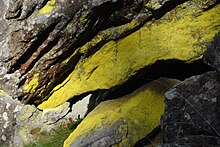Chrysothrix
| Chrysothrix | |
|---|---|

| |
| Chrysothrix chlorina, Unteres Rannatal, Austria | |
| Scientific classification | |
| Domain: | Eukaryota |
| Kingdom: | Fungi |
| Division: | Ascomycota |
| Class: | Arthoniomycetes |
| Order: | Arthoniales |
| Family: | Chrysotrichaceae |
| Genus: | Chrysothrix Mont. (1852) |
| Type species | |
| Chrysothrix noli-tangere (Mont.) Mont. (1852)
| |
| Synonyms[1][2] | |
Chrysothrix is a genus of lichen-forming fungi in the family Chrysothricaceae.[3] They are commonly called gold dust lichens or sulfur dust lichens,[4]: 253 because they are bright yellow to greenish-yellow, sometimes flecked with orange, and composed entirely of powdery soredia.[5] Apothecia are never present in North American specimens.[5]
They grow on bark or rocks, generally in shaded habitats.[5] They can sometimes be mistaken for sterile specimens of Chaenotheca, which usually has pinhead apothecia on tiny stalks, or Psilolechia, which usually has small, bright yellow apothecia.[5] Chrysothrix chlorina was traditionally used as a brown dye for wool in Scandinavia.[6]
Taxonomy[edit]
The genus was circumscribed by French botanist Camille Montagne in 1852, with Chrysothrix noli-tangere assigned as the type species.[7]
In 2012, Jack Laundon submitted a formal proposal to conserve the name Chrysothrix against Alysphaeria, published 25 years earlier than Chrysothrix, citing the need for "nomenclatural stability".[8] The proposal was accepted by the Nomenclature Committee for Fungi in 2017, who noted that Chrysothrix was already conserved against Pulveraria.[9]
Species[edit]
- Chrysothrix bergeri LaGreca (2020)[10] – southeastern United States; the Caribbean; Bermuda
- Chrysothrix caesia (Flot.) Ertz & Tehler (2011)
- Chrysothrix candelaris (L.) J.R.Laundon (1981)[11]
- Chrysothrix chamaecyparicola Lendemer (2010)[12] – eastern North America
- Chrysothrix chilensis D.Liu & J.-S Hur (2018)[13] – Chile
- Chrysothrix chlorina (Ach.) J.R.Laundon (1981)[11]
- Chrysothrix chrysophthalma (P.James) P.James & J.R.Laundon (1981)[11]
- Chrysothrix citrinella Aptroot & M.Cáceres (2017)
- Chrysothrix flavovirens Tønsberg (1994)[14]
- Chrysothrix frischii Kalb (2001)[15]
- Chrysothrix galapagoana K.Knudsen & Bungartz (2013)[16]
- Chrysothrix granulosa G.Thor (1988)[17] – South America
- Chrysothrix insulizans R.C.Harris & Ladd (2008)[18]
- Chrysothrix noli-tangere (Mont.) Mont. (1852)
- Chrysothrix occidentalis Elix & Kantvilas (2007)[19] – Australia
- Chrysothrix oceanica Räsänen (1944)[20]
- Chrysothrix onokoensis (Wolle) R.C.Harris & Ladd (2008)[18]
- Chrysothrix palaeophila Kantvilas & Elix (2007)[19] – Australia
- Chrysothrix pavonii (Fr.) J.R.Laundon (1981)[11]
- Chrysothrix placodioides G.Thor (1988)[17] – South America
- Chrysothrix septemseptata Jagad.Ram, Lumbsch, Lücking & G.P.Sinha (2006)[21] – India
- Chrysothrix susquehannensis Lendemer & Elix (2010)[12] – eastern North America
- Chrysothrix tchupalensis Elix & Kantvilas (2007)[19] – Australia
- Chrysothrix xanthina (Vain.) Kalb (2001)
References[edit]
- ^ "Synonymy: Chrysothrix Mont., Annls Sci. Nat., Bot., sér. 3 18: 312 (1852)". Species Fungorum. Retrieved 27 October 2021.
- ^ May, Tom W. (2017). "Report of the Nomenclature Committee for Fungi: 20". Taxon. 66 (2): 483–495. doi:10.12705/662.15.
- ^ Wijayawardene, Nalin; Hyde, Kevin; Al-Ani, Laith Khalil Tawfeeq; Somayeh, Dolatabadi; Stadler, Marc; Haelewaters, Danny; et al. (2020). "Outline of Fungi and fungus-like taxa". Mycosphere. 11: 1060–1456. doi:10.5943/mycosphere/11/1/8. hdl:11336/151990.
- ^ Field Guide to California Lichens, Stephen Sharnoff, Yale University Press, 2014, ISBN 978-0-300-19500-2
- ^ a b c d Brodo, I. M., S. D. Sharnoff, and S. Sharnoff. 2001. Lichens of North America. Yale University Press: New Haven. ISBN 0-300-08249-5
- ^ Uphof, J. C. T. 1959. Dictionary of Economic Plants. Hafner Publishing Co.: New York.
- ^ Montagne, J.P.F.C. (1852). "Diagnoses Phycologiae". Annales des Sciences Naturelles Botanique (in French). 18: 302–319.
- ^ Laundon, Jack Rodney (2012). "(2100) Proposal to conserve Chrysothrix, nom. cons., against an additional name, Alysphaeria (lichenised Ascomycota)". Taxon. 61 (6): 1321. JSTOR 24389118.
- ^ May, Tom W. (2017). "Report of the Nomenclature Committee for Fungi — 20". IMA Fungus. 8 (1): 189–203. doi:10.5598/imafungus.2017.08.01.12.
- ^ LaGreca, Scott (2020). "Chrysothrix bergeri (Ascomycota: Arthoniales: Chrysothricaceae), a new lichen species from the southeastern United States, the Caribbean, and Bermuda". Plant and Fungal Systematics. 65 (2): 509–514. doi:10.35535/pfsyst-2020-0029.
- ^ a b c d Laundon, J.R. (1981). "The species of Chrysothrix". The Lichenologist. 13 (2): 101–121. doi:10.1017/s0024282981000169. S2CID 85600317.
- ^ a b Lendemer, J.C.; Elix, J.A. (2010). "Two new species of Chrysothrix from eastern North America". Opuscula Philolichenum. 8: 51–58.
- ^ Dong, Liu; Soon-Ok, Oh; Jung-Shin, Park; Jae-Seoun, Hur (2018). "New species and new record of genus Chrysothrix (Chrysotrichaceae, Arthoniales) from South Korea and Chile". Mycobiology. 46 (3): 185–191. doi:10.1080/12298093.2018.1509511. PMC 6171421. PMID 30294478.
- ^ Tønsberg, T. (1994). "Chrysothrix flavovirens sp. nov. – the sorediate counterpart of C. chrysophthalma" (PDF). Graphis Scripta. 6 (1): 31–33.
- ^ Kalb, K. (2001). "New or otherwise interesting lichens. I". Bibliotheca Lichenologica. 78: 141–167.
- ^ Knudsen, Kerry; Bungartz, Frank (2013). "Chrysothrix galapagoana, a new species from the Galapagos Islands". Opuscula Philolichenum. 12: 174–179.
- ^ a b Thor, Göran (1988). "Two new species of Chrysothrix from South America". The Bryologist. 91 (4): 360–363. doi:10.2307/3242777. JSTOR 3242777.
- ^ a b Harris, R.C.; Ladd, D. (2008). "The lichen genus Chrysothrix in the Ozark Ecoregion including a preliminary treatment for eastern and central North America". Opuscula Philolichenum. 5: 29–42.
- ^ a b c Elix, John A.; Kantvilas, Gintaras (2007). "The genus Chrysothrix in Australia". The Lichenologist. 39 (4): 361–369. doi:10.1017/s0024282907006998. S2CID 85668733.
- ^ Räsänen, V. (1944). "Lichenes novi I". Annales Botanici Societatis Zoologicae Botanicae Fennicae "Vanamo". 20 (3): 1–34.
- ^ Jagadeesh Ram, T.A.M.; Sinha, G.P.; Lücking, Robert; Lumbsch, H.Thorsten (2006). "A new species of Chrysothrix (Arthoniales: Arthoniaceae) from India". The Lichenologist. 38 (2): 127–129. doi:10.1017/s0024282906005792. S2CID 84488444.
